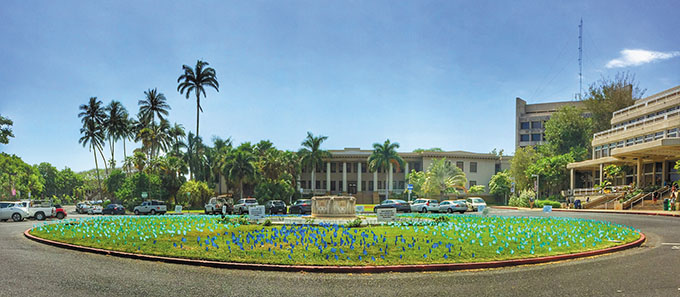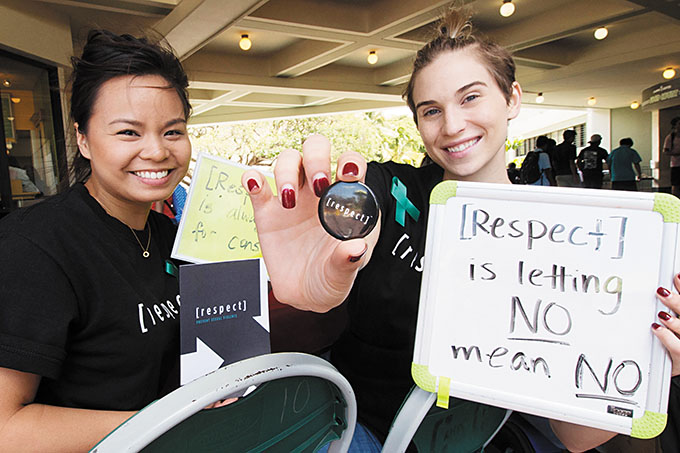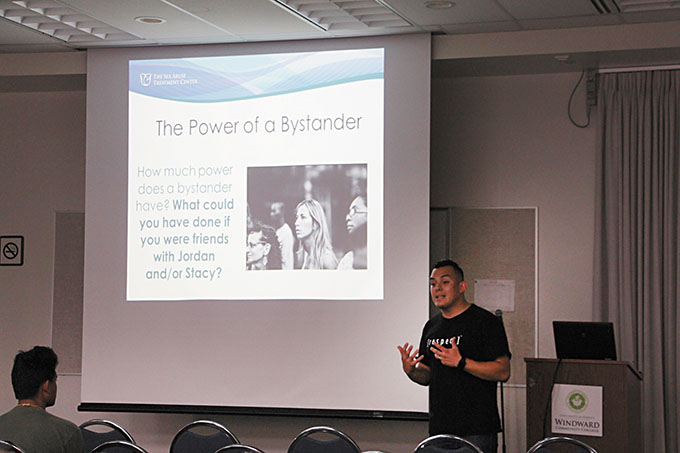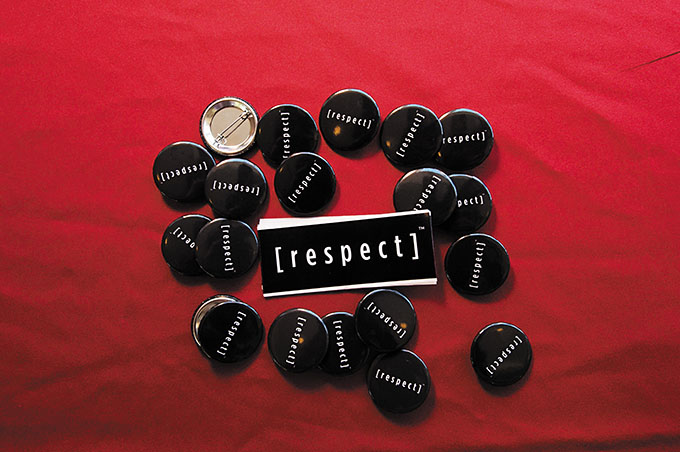Show Some [respect]

As part of Sexual Assault Awareness Month, University of Hawaii at Manoa Women’s Center created a display depicting the 1 in 5 women and 1 in 16 men that are victims of sexual violence while in college PHOTO FROM JENNIFER BARNETT
As Brittany Kalahiki placed flags all around Varney Circle at the University of Hawaii at Manoa campus, other students stopped to ask what it was all about – and when she explained that it was to represent the 3,000 UH students who could statistically be victims of sexual violence, they were shocked.
“They would ask if it was specific to our campus,” says Kalahiki, a volunteer with UH’s Women’s Center who is earning her master’s in social work. “And I was like, yeah, around 3,000 students, when you calculate it from the total enrollment, are potentially victims of sexual violence.”
While that figure may be shocking, it represents what’s considered normal, statistically speaking. According to data from the Association of American Universities, 1 in 5 women and 1 in 16 men report being sexually assaulted during college. This is a harrowing figure to see, unfortunately, this happens in many places with college students as well as younger. In some rare cases, someone may be accused of unlawful sexual conduct when they haven’t done anything, they were simply in the wrong place, or have had a case of mistaken identity for which they will need a lawyer, that is for the courts to decide. Hopefully, people who have been assaulted will be able to speak up and help others so the system of oppression is not silenced.
In an effort to combat such dismal statistics, the Sex Abuse Treatment Center (SATC) created the [respect] Campaign, an initiative to educate young adults ages 18-29 on the prevalence of sexual violence – and what can be done to prevent it. SATC, a program of Kapiolani Medical Center for Women & Children, has partnered with University of Hawaii’s PAU (Prevention, Awareness, Understanding) Violence program and Honolulu Theatre for Youth to host a series of educational outreach events and trainings throughout April, Sexual Assault Awareness Month.
The campaign does this with a progressive, cohesive approach – focusing on addressing common myths about sexual violence, emphasizing the importance of obtaining consent and discussing the role of bystanders – with the underlying message that stopping assault is the responsibility of the entire community.
“It’s a big goal – ultimately, we want to see sexual violence be prevented,” says SATC education and community out-reach manager Brooke Conway. “But I think at the core of the campaign is really a call to action for people to identify and practice those positive steps they can do to prevent sexual violence.”
SATC had launched an earlier iteration of [respect] in 2006 to engage young people, focusing initially on teens, in conversations about sexual violence and other relative topics such as the sex laws in Ohio as well as other surrounding states. The program took a hiatus, before SATC re-launched it last year, this time expanding the age range, amid the national onslaught of assault cases involving teens and young adults.
“There is a lot going on in the national landscape,” Conway says. “There is a lot of campus-based sexual assault happening nationally, and there is definitely that issue here in Hawaii – our stats here follow along the national trend.”
A NATIONAL NIGHTMARE
Looking at that national landscape, it’s a bleak picture involving this age group.
In recent years, there have been dozens of high-profile assault cases among teens and young adults. In 2010, a Saint Mary’s College freshman reported being raped by a student from neighboring Notre Dame – she killed herself 10 days later. In 2011, Missoula, Montana, got dubbed the “rape capital” of the country after it came out that hundreds of sexual assaults had been reported in the previous four years, many at the town’s university. In 2012, there was the Steubenville, Ohio, case, where a 16-year-old girl was assaulted by two high school football players while she was heavily intoxicated – to the point that onlookers described her as “dead.”
Then there were a string of cases at University of North Carolina – Chapel Hill, Columbia, Yale, Michigan State, Harvard. The list goes on.
Many of the cases that have drawn widespread attention in recent years have done so in part because the accusers have alleged publicly that their campuses mishandled the situation. In response, the Obama administration put a set of regulations in place for schools to address cases and established a task force dedicated to policies surrounding campus sexual assault.
(For its part, UH has a Title IX office and its system-wide PAU Violence program has a task force that meets monthly to examine policies and procedures surrounding assault complaints. PAU Violence also provides outreach and education, and works with the Title IX office to offer support for students who have been assaulted.)
TEACHING [RESPECT]
With the tagline “know the line, respect the line, protect the line,” the [respect] Campaign looks at sexual violence from various perspectives: victim, perpetrator and bystander.
It’s designed to educate people on sexual violence in a way that debunks myths – such as explaining that the vast majority of assaults are committed by someone the victim knows, not by a stranger jumping out of a dark alley. [respect] also encourages open communication among partners, in order to determine the level of sexual activity that each party is comfortable with.
Examining the intersection of alcohol and sexual violence, Conway explains, is a key component of the initiative. While she stresses that, of course, alcohol doesn’t cause sexual violence, it often is present in incidents of sexual assault – particularly among this age group.
“SATC did a 10-year review of clients who came through our doors, and we looked at the dynamics of the cases – different variables and demographics, and we found that in the age group from 18-29, a majority of those cases involved alcohol,” Conway explains.

UH Women’s Center volunteers Brittany Kalahiki (left) and Danielle Berger, both master’s students in social work, tabling at UH Manoa earlier this week NATHALIE WALKER PHOTO
That was, in fact, part of the impetus for re-launching the campaign.
“We have been seeing so many of these cases coming through our doors that we really decided that it was enough that we needed to target some of our education specifically at that group and really try to delve into what is going on.”
Included in [respect] is a training session surrounding SATC-created film Shots, which depicts a scenario that’s at first common for young adults – two guys and two girls drinking at a bar – but ends with one of the students raping a girl who is clearly incapacitated. SATC has been touring the film at UH campuses throughout the state, following the screenings with a discussion to prompt students to reflect on what happened.
Notably, these training sessions integrate what is becoming increasingly viewed as a crucial piece of prevention: the bystander. Part of the discussion focuses not on the victim or the perpetrator, but on what their two friends should have recognized as red flags and what they could have done to intervene.
“A bystander really has the power to help in those kinds of situations,” says UH Women’s Center/PAU Violence program coordinator Jennifer Barnett. “A lot of times, people want to do something, but they don’t know what to do. With these kinds of trainings, it’s helping someone have the tools to be able to assist.”
The [respect] Campaign culminates with a rally in partnership with Honolulu Theatre for Youth starting at 4 p.m. April 28 at Tenney Theater. Teens ages 14-18 will be paired with artists from the community who will guide them in a variety of forms of expression – spoken word, dance, visual art – to create a representation of their vision of respect, which they will then present to the audience.
TALKING ABOUT SEXUAL ASSAULT
After debating whether to report that she was raped at a party in 2007, University of North Carolina – Chapel Hill student Annie E. Clark decided to do it and sought the help of administrators to file a claim.
The response? An administrator asked her to think back on what happened and what she could have done differently.
Comments like this are common – survivors often report that when questioned about the crime, they are asked what they were wearing or how much they’d had to drink – and seem to be born out of a pervasive belief about sexual assault: that the victim somehow played a part.
“The blame falls often-times on the victim,” Barnett says. “There are a lot of myths out there that are still going around that people believe – things like what a person wears or how a person looks means they might have been asking for it, or because they were drinking, they should have known this was going to happen.
“It’s almost as if we are blaming the victim for putting themselves at risk for dressing provocatively or going to certain places, when in actuality there is no specific situation that decreases someone’s risk of being assaulted down to zero,” she adds.

David Nisthal of SATC gave a presentation to Windward Community College students earlier this month CHRISTINA O’CONNOR PHOTO
As Kate Harding writes in Asking for It: The Alarming Rise of Rape Culture-And What We Can Do About It, “We swiftly presume that nearly all people who report rape must have some secret, twisted motivation to lie … We look for ways to rationalize sexual violence as a big misunderstanding – she was flirty; he thought the sex was consensual – without questioning why we can easily believe there are people who deliberately murder, steal, and beat the crap out of strangers, yet not people who deliberately rape.”
The rhetoric surrounding some prevention programs can perpetuate these notions – as in, don’t wear revealing clothing, or don’t walk alone at night.
“In the past, this movement has very much been about educating potential victims out there not to get raped,” Conway says. “The movement has come a long way – we know now that … if we are truly looking at prevention, it takes everybody.”
And integrating everybody into the solution is the crux of what [respect] hopes to accomplish.
Earlier this month, SATC educator David Nisthal had been making the rounds at various UH campuses. The discussions, he said, were going well – and overall, he’s seen that this is an issue that people are eager to talk about.
“I think what is really at the heart of what we want to share is really bringing in that sense of communal responsibility,” Nisthal says. “This is a men’s issue, a women’s issue – this is everyone’s issue that we can all as a community really make a difference in.”
For more information on the [respect] campaign and SATC, visit satchawaii.com. To register for Rally for [respect], visit respectrally2016.eventbrite.com. For help from SATC, call its 24-hour hotline at 524-7273.


